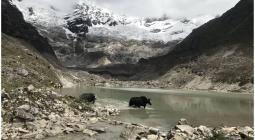‘It looked like we were at sea’: UK River and Rowing Museum faces up to climate threat
Near flooding of Henley-on-Thames building prompts decision to tell the story of climate crisis
From the reconstructed riverside of The Wind in the Willows to an historic Georgian rowboat used in the inaugural Oxford-Cambridge race, the exhibits at the River and Rowing Museum celebrate the importance of British rivers.
But the award-winning building in Henley-on-Thames – designed by the modernist architect David Chipperfield – is facing a significant threat from the very river beside which it resides.
In January the museum, which Chipperfield designed on stilts due to its proximity to the Thames, came the closest it had come to flooding after water rose within 5cm (2in) of the building’s raised floor.
The museum’s director, the former British rowing champion Steve O’Connor, said significant flooding around the 26-year-old museum was no longer a “once in a generation” event, with the climate crisis increasing the frequency and severity.
“We’ve often heard these floods as once in a generation but we’re having that now every 10 years,” O’Connor said, looking over the nearly overflowing flood plains outside the windows of the museum cafe.
‘“I don’t think it’s fair to say now that it’s once in a generation, it’s once a decade, and for years we’ve had warnings that we will have wetter winters and I think now we have to agree that those wetter winters are here. So we should be planning for that now.”
O’Connor, with his background in rowing including winning gold medals at the British Championships in 2010, is passionate about rivers and the advantages they can bring for active lifestyles and biodiversity.
After visitor numbers halved from about 120,000 to 60,000, he said he wanted to revamp the museum to place the climate crisis and its impact on rivers at the heart of its purpose, alongside the celebration of rowing and the town of Henley-on-Thames.
“What we have to do is tell the story of climate change, and not necessarily, I think, actually convince people one way or the other, whether it’s a man-made problem or not, but actually demonstrate using facts that the climate is changing.
“If we can use an interactive in an almost entertaining way to tell people that message and get them to think about it, hopefully then we start getting the mass of people to think about solutions. I suppose in some ways, try and remove the politics from it … also try and remove some anxiety and get people to focus on practical steps they can take.”
In terms of steps to prevent the museum’s walls being breached, he said planning rules that allow developments to be built upstream without considering the impact downstream needed to be urgently reviewed, flood plains needed to be protected and Victorian sewerage systems must be modernised.
While the museum avoided being breached in January, archive materials stored in containers in the car park were damaged, as were electrics, and the museum lost a significant amount of business from having to close in school holidays.
“Where we are now, looking out the cafe, it looked a lot like we were at sea,” O’Connor said. “We were completely surrounded by water on all sides. And certainly no one in recent memory at the museum had ever seen it that bad. And it really was a powerful demonstration of what is happening and the importance for us here of the flood plains and ensuring that we protect them.”
O’Connor said he did not want to be drawn into politics but strongly suggested that planning regulations be reviewed. “Developments, whether that be residential or commercial that are built, which don’t have flooding in mind and don’t have thought towards impact downstream is important.
“We need to ensure that that is much more at the top of people’s minds, and local authorities, when approving planning applications.”
The museum is surrounded by two flood plains, Marsh Meadow and Mill Meadow, their value underlined by the waterlogged appearance. O’Connor said that without them he is certain the museum would have been deluged.
Looking ahead, he said he hoped the site would become a key centre to host events on healthy rivers and the impact of the climate crisis.
“When I started, I asked myself: ‘Why do museums tell stories of the past?’ And ultimately, it’s about predicting the future,” O’Connor said. “If you zoom out, you can talk about the various ice ages that formed the river and then get more narrow, looking at the last few years and the wider impact of carbon emissions.
“Then when you leave this museum, you know what to do in order to try and prevent it happening.”
Cover photo: The museum seen from above during flooding in January. Photograph: Richard Pinches





